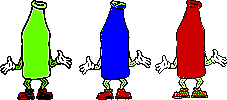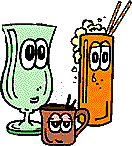 | Does the
COLOR
of Foods and Drinks Affect The Sense of Taste? |
 | Does the
COLOR
of Foods and Drinks Affect The Sense of Taste? |
 Have you ever had green cherry drink or brown strawberry juice? Some people
have! Of course, they were in experiments to see how the color of a drink
affects the way the drink tastes. Flavor can be influenced by many
factors such as the way a food or drink looks, smells, and feels. Let's
look at some studies that have examined how color affects the way foods
and drinks taste. Have you ever had green cherry drink or brown strawberry juice? Some people
have! Of course, they were in experiments to see how the color of a drink
affects the way the drink tastes. Flavor can be influenced by many
factors such as the way a food or drink looks, smells, and feels. Let's
look at some studies that have examined how color affects the way foods
and drinks taste. |
| Paper | Methods | Results | ||||||||||||||||||||||||||||||||||||||||||||||||||||||||||||||||||
| 1. Philipsen D.H., Consumer age affects response to sensory characteristics of a cherry flavored beverage. Journal of Food Science, 60:364-368, 1995. | Test subjects were divided into two groups: a young
adult group (18-22 years old) and an elderly group (60-75 years old).
The subjects were given cherry-flavored drinks that differed in sweetness
and the amount of red coloring.
|
| ||||||||||||||||||||||||||||||||||||||||||||||||||||||||||||||||||
| 2. Roth, H.A., et al., Psychological relationships between perceived sweetness and color in lemon- and lime-flavored drinks. Journal of Food Science, 53:1116-1119, 1988. | Subjects were between 20-25 years old. Five different sweetness levels and five different colors of lemon and lime drinks were used. | As the color of a drink became more intense, people
reported that the drink became more sweet.
| ||||||||||||||||||||||||||||||||||||||||||||||||||||||||||||||||||
| 3. DuBose C.N., Effects of colorants and flavorants on identification, perceived flavor intensity, and hedonic quality of fruit-flavored beverages and cake. Journal of Food Science, 45:1393-1399, 1415, 1980. | Subjects tasted grape, lemon-lime, cherry and orange drinks
with different colors. |
When subjects tasted the drinks and were able to see the
"correct" colors of the drinks, they were always able to identify the
taste of the drink correctly. However, when they could not see the
color of the drink, they made mistakes (see table). For example, 70% of
the people who tasted the grape drink, said it was grape. However, 15% of
the people thought it was lemon-lime. Only 30% of the people who tasted
the cherry drink thought it was cherry. Most people thought the cherry
drink was lemon-lime (40%).
4. DuBose et al., Effects of colorants and flavorants on identification,
perceived flavor intensity, and hedonic quality of fruit-flavored
beverages and cake. Journal of Food Science, 45:1393-1399, 1415,
1980. |
The cherry, lemon-lime and orange drinks and a "no-flavor"
drink were colored either red, orange, green or given no color.
Also, a solid food was tested: a white cake with added yellow
coloring and lemon flavor. |
|
5. Johnson, J. and Clydesdale, F.M., Perceived sweetness and redness in
colored
sucrose solutions. Journal of Food Science, 47:747-752, 1982. |
Test subjects were between 19-50 years old. Five
different sucrose (sugar) solutions and five different intensities of
red were used. |
Subjects reported that sucrose solutions that were more red
tasted sweeter. |
6. Chan, M.M. and Kane-Martinelli, C., The effect of color on perceived
flavor intensity and acceptance of foods by young adults and elderly
adults.
Journal of the American Dietetic Assn., 97:657-659, 1997. |
Young adults (20-35 years old) and elderly adults (60-90
years old) were used as test subjects. Chicken bouillon (three yellow
color intensities) and chocolate pudding (three brown color intensities)
were tested. The bouillon was tested for overall flavor, chicken flavor,
saltiness and appearance; the pudding was tested for overall flavor,
chocolate flavor, sweetness and appearance. |
7. Christensen, C.M., Effects of color on aroma, flavor and texture
judgments of food. Journal of Food Science, 48:787-790,
1983. |
Test subjects were between 18-35 years old. Subjects were
given normally colored margarine, raspberry gelatin, soy bacon,
orange drink and American cheese OR uncolored samples of these
foods or blue American cheese. |

8. Christensen C.M., Effect of color on
judgments of food aroma and flavour intensity in young and elderly adults.
Perception, 14:755-762, 1985. |
Test subjects were divided into two groups: young adults
(21-40 years old) and elderly adults (65-85 years old). Test foods were
processed cheese and grape-flavored jelly, each with three different color
and flavor levels. Subjects were given paired food samples and asked
which one had a more intense flavor and odor. |
There was no difference between young and elderly adults in
their ability to discriminate odor or flavors. Color failed to change
the perception of aroma and flavor strength. | 9.
Oram, N., The influence of flavor and color on drink indentification by
children and adults. Dev. Psychobiology, 28:239-46,
1995. |
Test subjects were divided into five groups: ages 2-7
years old; 8-9 years old; 10-11 years old; 12-18 years old; 19 years old
and older. Subjects were given drinks flavored with chocolate, orange,
pineapple or strawberry. The drinks were colored either brown, orange,
yellow or red. After tasting each drink, the subjects had to choose
whether the drink was chocolate, orange, pineapple or strawberry. |
Younger subjects made more color-associated errors. In
other words, they relied on the color of the drink more than the
older subjects to make a decision about its taste. |
 10.
King, B.M. and Duineveld, C.A., Factors affecting the perception of
naturalness and flavor strength in citrus drinks. Ann. NY
Acad. Sci., 855:847-853, 1998. |
Test subjects were "middle-aged" women. Subjects were give
an orange drink that varied in aroma, bitterness, sweetness and color
(red). |
11.
Stillman, J.A., Color influences flavor identification in fruit-flavored
beverages. Journal of Food Science, 58:810-812, 1993. |
Subjects were at least 15 years old. Uncolored,
red, yellow-orange and green colors were used to test the ability of
subjects to identify raspberry-flavored and orange-flavored drinks. |
The ability to identify raspberry and orange flavors
correctly was reduced in uncolored and "odd-colored" drink
samples. | | |||||||||||||||||||||||||||||||||||||||||||||
So What? So, color may influence the taste of food. Why is this important?
These experiments are important to scientists who are studying how
vision interacts with taste and odor. It is apparent that color
can affect the perception of foods and drinks. It is likely that people
learn and become familiar with specific combinations of colors and tastes.
These learned associations may alter our perceptions and create
expectations about how a food should smell and taste. The mechanisms that
underlie these interactions are not known.
So, color may influence the taste of food. Why is this important?
These experiments are important to scientists who are studying how
vision interacts with taste and odor. It is apparent that color
can affect the perception of foods and drinks. It is likely that people
learn and become familiar with specific combinations of colors and tastes.
These learned associations may alter our perceptions and create
expectations about how a food should smell and taste. The mechanisms that
underlie these interactions are not known.Food and drink companies are also very interested in the results of these experiments. It is important for companies to know how their products are perceived by consumers. Companies work very hard to make their foods and drinks the most desirable so they can sell more product. Companies are always looking for ways to make their products more appealing to consumers. If changing the color of a food or drink can sell more product, you can be sure that the company will make the change. |
 | Try to change the flavor of a drink or jellybean by altering its color with these experiments. |
| BACK TO: | Neurological and Mental Disorders | Exploring the Nervous System | Table of Contents |
![[email]](./gif/menue.gif) Send E-mail |
 Get Newsletter |
 Search Pages |